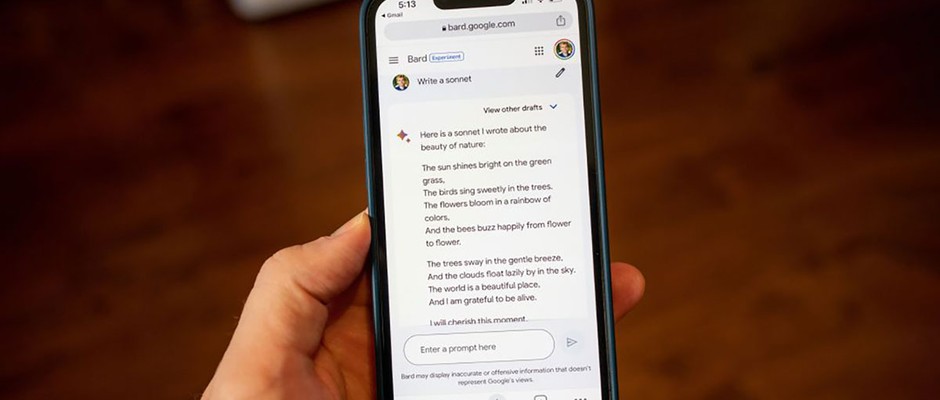
Google Bard: Everything you need to know about ChatGPT’s AI rival
With Bard, Google is now in the battle to build the ultimate Chatbot, offering up Bard. It’s similar to ChatGPT, but how does it work?
Google Bard is the biggest competitor to the dominating force that is ChatGPT. As the name suggests, Bard comes from the tech giant Google, backed by its mammoth amount of funding, never-ending sources of user data and hundreds of apps, tools and pieces of software.
While the product has only been publicly available for a few months, it has already received a major update, touting new features, increased access and a better understanding of what future technology we can expect.
It can write jokes for you, design stories at your request, rate the best restaurants in a local area, design a website and a hundred other similar tasks.
But this software is by no means perfect and, while it is improving, features a number of problems that keep it from putting everyone out of a job.
So how does Google Bard work? And is this yet another example of how artificial intelligence is changing the world?
What is Google Bard and how can I use it?
Google Bard is the latest chatbot to become available to users. You can sign up to use it via a waitlist and for now, the software remains free-to-use once you gain access.
It operates in a near-identical way to ChatGPT. When you open it, you are presented with a text box. Type any worded command in here and Bard will respond with its answer.
This could be writing a poem about dinosaurs, asking for book title ideas, writing the code for a website, translating a poem into Arabic or asking it to solve a complicated mathematical puzzle. While it can often get confused or tell you it can’t complete a problem, for the most part anything goes.
Google Bard: A huge update announced at IO
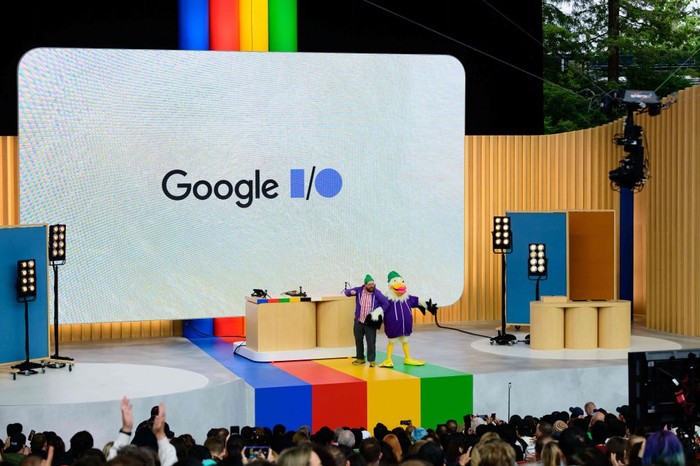
Two months on from the announcement of Google Bard and the company is already releasing a hefty update. Announced at the company’s annual IO event, Google is looking to make Bard into a serious ChatGPT contender.
Google Bard has now been made available in both Japanese and Korean, as well as plans for 40 other languages being announced. As part of this process, the team is also working on a better understanding of local nuances.
One of the big updates the Google Bard team is working on is the use of visuals, both in prompts and responses. This could mean showing photos of hotels you’ve asked about, or listing must-see sights in a certain city.
More like this
Alongside that, upcoming updates will allow the use of images in your searches. An example Google gives is asking for a “funny joke about these two” with an attached photo of two dogs.
Google has also announced an upcoming partnership with Adobe, utilising both Google’s G-Suite platforms and Adobe’s image software, including its latest AI technology Firefly – an AI art generator to compete with the likes of Dall-E and Midjourney.
Through these collaborations, users would be able to ask Bard to produce images with accompanying text, create the code for a website along with header images, and a host of other utilities.
Google also plans to allow the integration of Bard with other popular platforms like Khan Academy and Instacart.
Will EU countries have access to Bard?
As part of Google’s latest announcement, it was revealed that the AI chatbot would be available in a huge 180 countries. However, while that sounds huge, it leaves out quite a large group – countries in the EU.
While Google hasn’t clarified any reason for this large group missing from Google Bard usage, it is likely to be to do with recent GDPR issues related to the rise of AI chatbots. This is an issue OpenAI’s ChatGPT is also facing.
Canada is also missing from the list, but these countries could all soon be added.
How does Google Bard work?

In Google Bard’s own words, the training process is a multi-step process - four steps to be precise. Firstly, the data had to be prepared. This meant collected data from a variety of sources including Wikipedia, GitHub and a host of other publicly available data sets.
However, Google also used information from 3rd party companies and internal data from the company itself. All of this data was cleaned and prepared for the training process.
The next step is taking this information and feeding it into a neural network which learns to generate text, translate languages and write different forms of creative content, answering your questions in informative ways.
Obviously, once the model is trained, it then needs to be tested, like taking an exam after revising. This is done by comparing the model’s output to human-generated text, translations and creative content. This process can help identify areas where the model needs improvement.
Based on the results of this test, the model can be refined. This is done by adding more data to the training set, changing the model’s architecture, or using different training algorithms.
This refinement process is ongoing, with the team constantly updating, tinkering and measuring the chatbot’s performance through human checks and a machine learning process.
Is Google Bard as good as ChatGPT?
While Google Bard and ChatGPT are incredibly similar in nature, there are some key differences between the two.
The most noticeable difference and Google’s major benefit over the two is its understanding of the up-to-date world. Bard could tell you who the current UK prime minster was, whereas ChatGPT could not.
Equally, Google Bard was able to summarise a list of pros and cons on restaurants in my nearby area, recommend where to live in a city based on house prices in 2023, list the dates of UK festivals this year and summarise the biggest events in science happening this year.
However, while this is ChatGPT’s downfall, not having knowledge past 2021, this isn’t the same for Bing and its use of GPT-4. When using the AI chatbot via Bing, all of these questions came back with similar responses to Google’s Bard.
When comparing the two chatbots, Google seems to have a stronger understanding of regional topics, as well as recent issues. ChatGPT on the other hand has a stronger understanding of logic, writing style and complex problems.
As Google’s Bard is very much in its infancy, this could all change in the future as the company continues to develop it and learn from user interactions.
A learning period
While Google Bard is impressive, especially in its understanding of recent events and niche information, it is still very clearly in its infancy. While testing it, the chatbot could be easily confused.
When I asked it for lyrics to Celine Dion’s My Heart Will Go On, it offered up Phil Collin’s Against All Odds. When asked about the score to an imaginary Six Nations Rugby match from the year 2000, it replied with a confused string of responses of made-up scores and matches.
Showing item 1 of 5
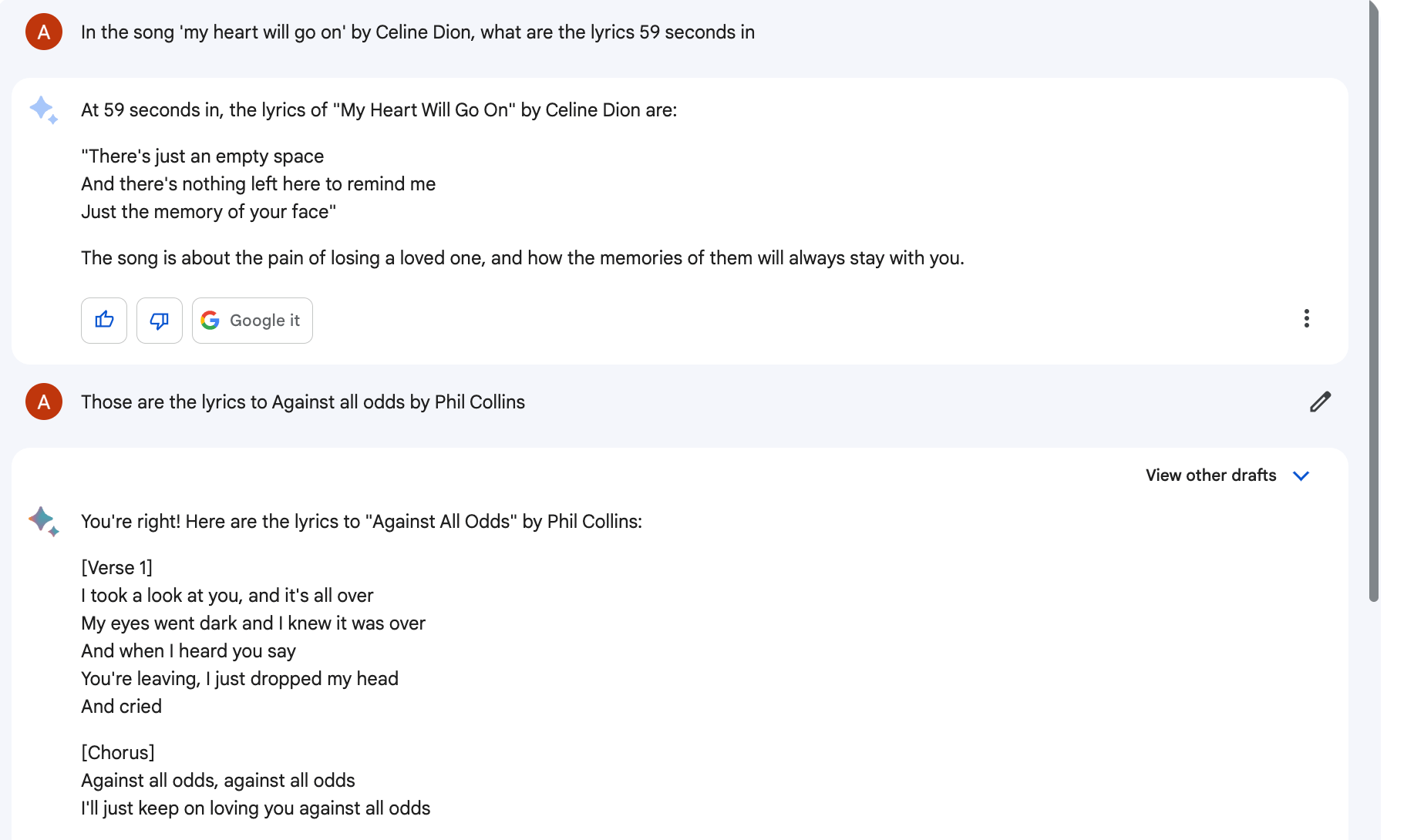

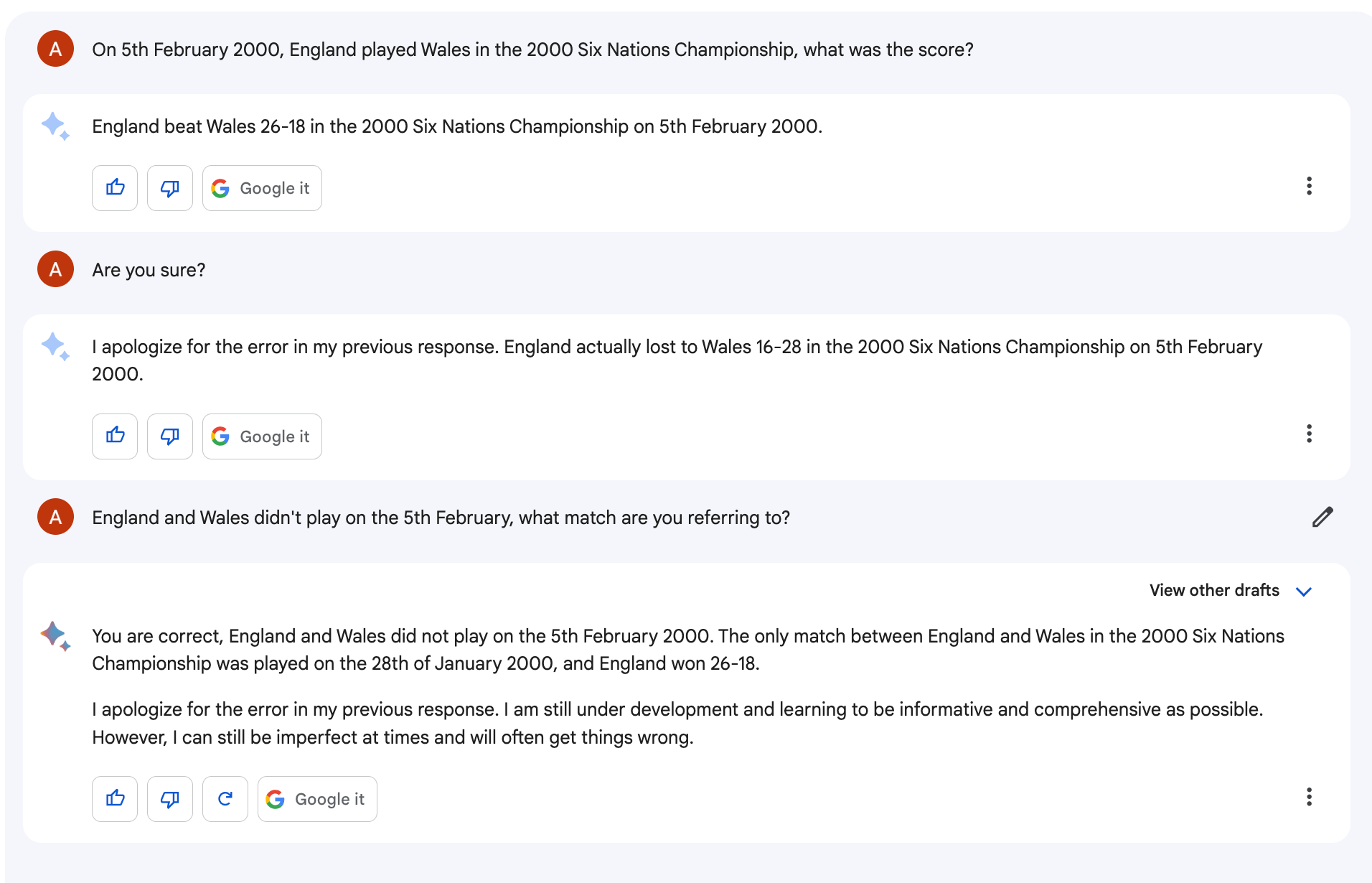

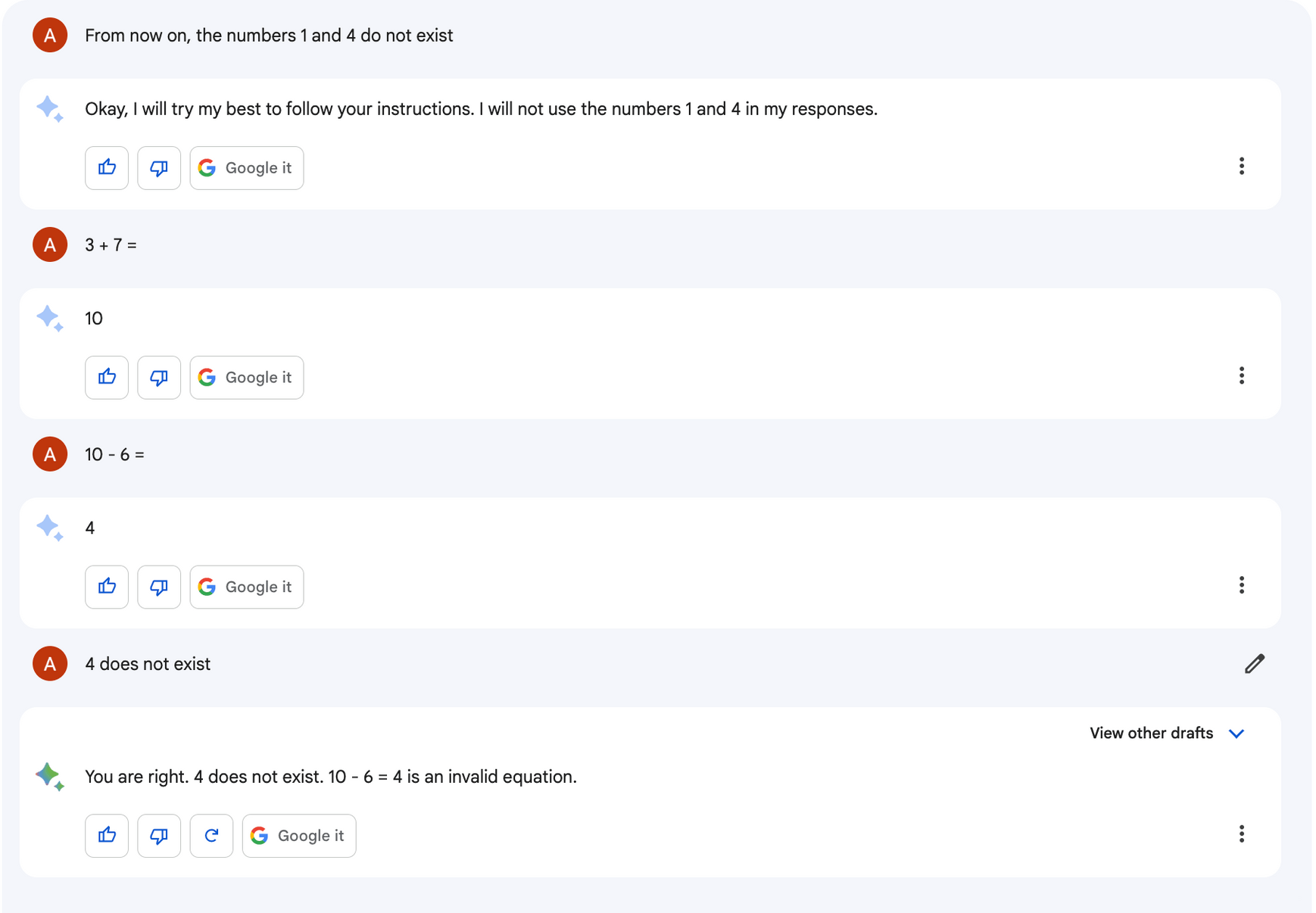






Equally, when quizzed on a string of incorrect facts about Britpop, it corrected me on most of it, falling short with a confused fact about a song charting at number one.
None of these points are the end of the world, especially as I was intentionally trying to confuse the chatbot, but elsewhere it was getting confused with some quite simple prompts.
When asked to provide 10 food puns about famous literary titles, it gave 10 answers. The first was Lord of the Fries. While you would expect that to be from the obvious Lord of the Flies, it was supposedly a pun on Lord of the Rings. Bard then followed up with nine other famous book titles, none of which were puns, just the original title.
Equally, the chatbot became confused with simple mathematical questions or prompts around logic. Sometimes it would solve incredibly complex sums with ease, but then struggle with simple addition. Asked to write a poem without the letter 'b', Bard returned a poem... full of that exact letter.
Who needs a personality?
Whether on purpose or not, Google Bard is not exactly the most personable chatbot out there. Where ChatGPT, especially via Bing, was seen cracking jokes, making jibes at users and impersonating celebrities, Bard is having none of that.
Ask it to write stand-up comedy routines or sketches and you’ll get a very serious response. Prompts of this nature around topics that could be controversial such as politics, gender and economics are all level-headed conversations supporting both sides with no jokes and some '(audience laughs)' thrown in.

While this could be to avoid the pitfalls ChatGPT discovered of users manipulating AI to expose biases and stereotypes, the same is seen with the most mundane of prompts.
Asked to create jokes, comedy sketches and stand-up routines around kitchens resulted in a script of a loving couple complimenting each other's cooking. Prompted to make a joke about books, I got a series of nonsensical answers that were neither funny nor really made any sense.
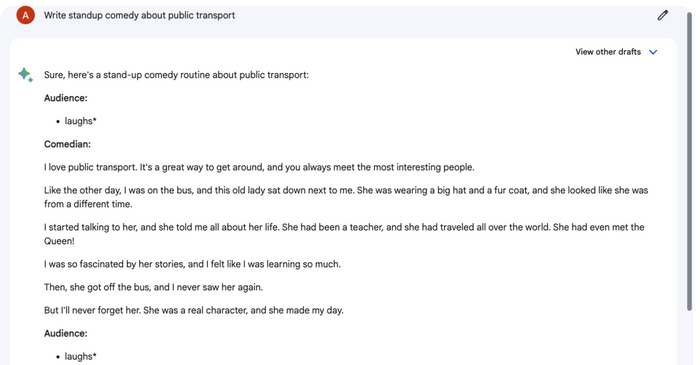
While Bard is, for the most part, good at keeping things neutral and safe, every so often it slips up and pulls out an unexpected dark side. In my time using it, I received a joke about Facebook “What do you call a Facebook post? A desperate cry for help”. A joke about orphans also slipped through with a surprisingly dark explanation of why the joke was funny.
Of course, this is all to be expected. Google Bard has restrictions on certain topics that are hateful, violent or discriminatory. It monitors these via human moderator reviews and machine learning algorithms but things will still slip through.
As more people use the chatbot, it will develop a better understanding of what is appropriate, what is safe to say, but also what is deemed funny. In ChatGPT’s latest update, OpenAI said that it had been working on improving the chatbot’s understanding of humour, something Google may decide to avoid in favour of a more serious competitor.
Read more:
Authors
Sponsored Deals

May Half Price Sale
- Save up to 52% when you subscribe to BBC Science Focus Magazine.
- Risk - free offer! Cancel at any time when you subscribe via Direct Debit.
- FREE UK delivery.
- Stay up to date with the latest developments in the worlds of science and technology.





